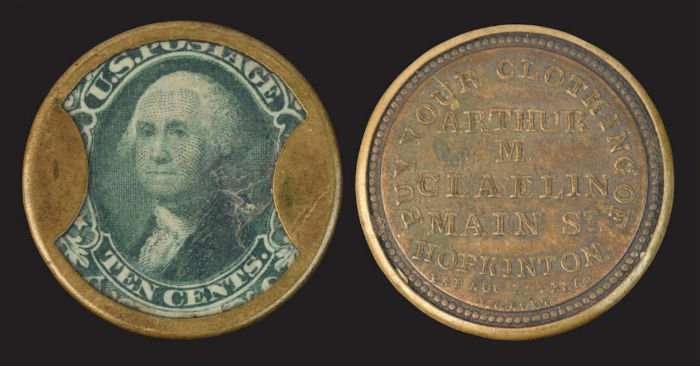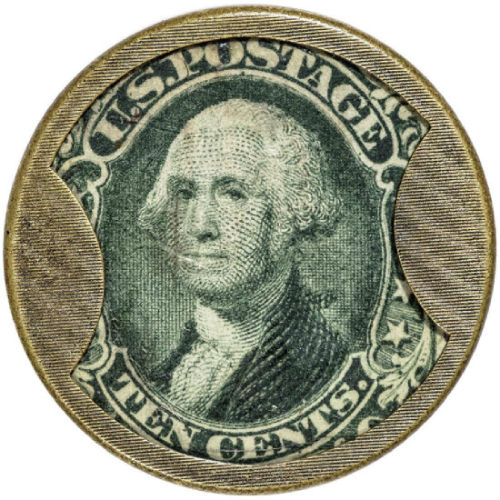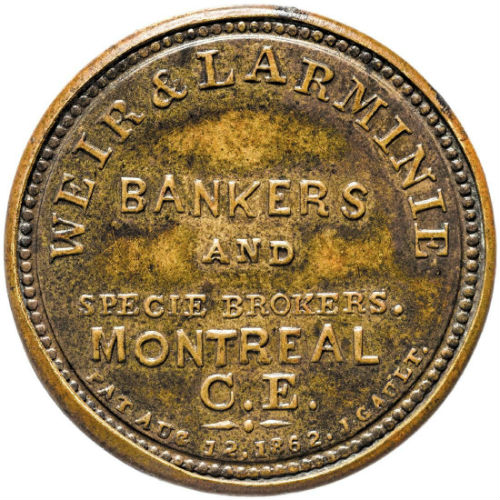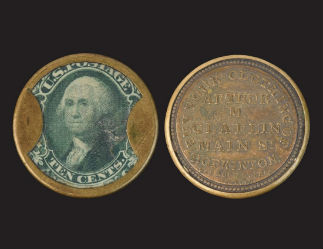
NEW YORK – It’s a stamp. It’s a coin. It’s the best of both worlds. Encased postage stamps were created during the second year of the Civil War when actual coin currency grew scarce. People on both sides of the battle lines in the North and the South were hoarding gold and silver coins to the extent that by the summer of 1862, a coin could hardly be found, sending businesses into turmoil.
In need of an emergency substitute currency, the 37th U.S. Congress passed an act in July 1862, making postage stamps legal as payment notes. The only problem was their flimsy nature made them subject to wear and tear. They got dirty, torn and humidity could make them stick together because of their gum adhesive backing.
As a solution, businessman inventor John Gault patented the encased postage stamp that ensconced a postage stamp inside a round metal cover, first made of silver, which resembled coins. When silver proved too expensive to keep using, Gault switched to brass.

He marketed these to businesses and merchants to use as coinage at a healthy profit above their face value. He also charged them an additional premium to print advertising for their shops on the backs of the casements. He printed custom cases with advertising for some 30 companies. Among the best known were J.C. Ayer’s and Drake’s Plantation Bitters. The higher the money denomination, the scarcer they were, and today, these generally bring higher prices than lower denominations, which were printed in larger quantities.
“Gault’s largest client was J.C. Ayer & Co., a manufacturer of ‘medicines’ and medical remedies. [James Cook] Ayer was well versed in the advantages of keeping a product’s name in front of the public, as he had done with newspaper advertising and almanacs,” according to an article by Steve Swain on the Stamp-Collecting-World website. Swain says many Ayer’s stamps remain in existence today because so many were originally produced. A popular Ayer’s encased stamp has the company name and “Sarsaparilla To Purify the Blood” inscribed on the back. Reportedly, the three separate types of encased postage stamps issued for Ayer’s in Lowell, Mass., accounted for about 90 percent of the total sold by Gault. Besides his Sarsaparilla drink, Ayer also used this hybrid currency to market “cathartic pills.”

Among scarcely seen pieces for other companies is the 5-cent piece for the Aerated Bread Company of New York City, which was in business for only two years.
It is estimated Gault sold about $50,000 of his encased postage stamps, not sufficient to fix the coinage crisis during the war years and his currency reign was fairly short-lived as the government issued postal currency in several coin denominations including 5 cents, 10 cents and 25 cents. “Of the approximately 750,000 pieces sold, only 3,500-7,000 are believed to have survived,” according to an online article on encased postage stamps by James E. Kloetzel on Arago, a website dedicated to philately.

The government also issued fractional currency the following year and metal coinage production ticked back up, soon rendering the need for encased postage stamps obsolete. These were, and are, quite collectible, however. They hold much cross-collecting appeal as a notable numismatic hybrid, a curious object in American history and an early form of advertising.
“Encased postage stamps are an interesting chapter in the annals of numismatics,” said Q. David Bowers in a blog for his company, Stack’s Bowers Galleries in Santa Ana, Calif., and New York City. Collecting of these objects even outstripped silver Morgan dollars by mint marks in the early Twentieth Century. In August 2019, examples from Bowers’ personal collection sold, including a 1-cent piece from Arthur M. Claflin that earned $16,800 and a 10-cent encased postage stamp, issued by L.C. Hopkins & Co., which realized $4,080, according to an article by Coin World.

On LiveAuctioneers’ price results database, the highest price for an encased postage stamp was a 3-cent piece, issued by Joseph L. Bates, which took $18,000 in October 2014 at Early American History Auctions in Rancho Santa Fe, Calif. The piece has the Boston merchant’s name printed on the back along with “FancyGoods” as one word. Author Fred L. Reed, who wrote extensively on encased postage stamps and Civil War currency, had previously noted this variety as non-existent, therefore, this is likely the only example known.
Encased postage stamps are a quirky footnote in the history of numismatics and early advertising and still attracting collectors today.



